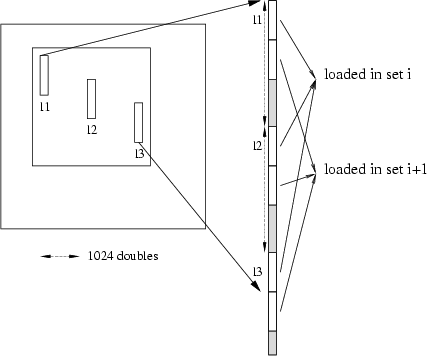



Next: data blocking.
Up: 4. Memory bandwidth and
Previous: false sharing.
Mutual exclusion appends when 2 or more memory lines are needed but cannot be
in cache all-together because they fit in the same cache line and successive
access cause exclusion of the memory lines previously loaded.
This is a real problem for direct mapped caches where a memory line can be in
only one cache line. N way set associative caches solve this problem by
allowing a memory line to be in N different cache lines, the N locations
are called a set; this is the case of the P6 processors where L1 cache is 2 way set associative and it avoids mutual
exclusion for all Level 1 BLAS with less than 3 vector operands (like ddot and
daxpy). Mutual exclusion can also appends for matrix operations like dgemm:
when using a block method, leading dimension12can be such that some memory lines share the same set into cache avoiding more
than N of them at the same time: on figure ![[*]](cross_ref_motif.png) the
memory lines l1 l2 and l3 are 1024 doubles spaced (remember that PII L1 cache
has 256 sets each containing 2 line of 32 bytes) so they fit into the same L1
cache set which can hold only 2 different memory lines. Thus l1, l2 and l3
and subsequent lines exclude mutually. The solution to have the block in cache
is to make a copy into contiguous memory and this is the solution adopted in
ATLAS.
the
memory lines l1 l2 and l3 are 1024 doubles spaced (remember that PII L1 cache
has 256 sets each containing 2 line of 32 bytes) so they fit into the same L1
cache set which can hold only 2 different memory lines. Thus l1, l2 and l3
and subsequent lines exclude mutually. The solution to have the block in cache
is to make a copy into contiguous memory and this is the solution adopted in
ATLAS.
Figure:
Mutual exclusion in block access.
 |



Next: data blocking.
Up: 4. Memory bandwidth and
Previous: false sharing.
Thomas Guignon
2000-08-24


![[*]](cross_ref_motif.png) the
memory lines l1 l2 and l3 are 1024 doubles spaced (remember that PII L1 cache
has 256 sets each containing 2 line of 32 bytes) so they fit into the same L1
cache set which can hold only 2 different memory lines. Thus l1, l2 and l3
and subsequent lines exclude mutually. The solution to have the block in cache
is to make a copy into contiguous memory and this is the solution adopted in
ATLAS.
the
memory lines l1 l2 and l3 are 1024 doubles spaced (remember that PII L1 cache
has 256 sets each containing 2 line of 32 bytes) so they fit into the same L1
cache set which can hold only 2 different memory lines. Thus l1, l2 and l3
and subsequent lines exclude mutually. The solution to have the block in cache
is to make a copy into contiguous memory and this is the solution adopted in
ATLAS.